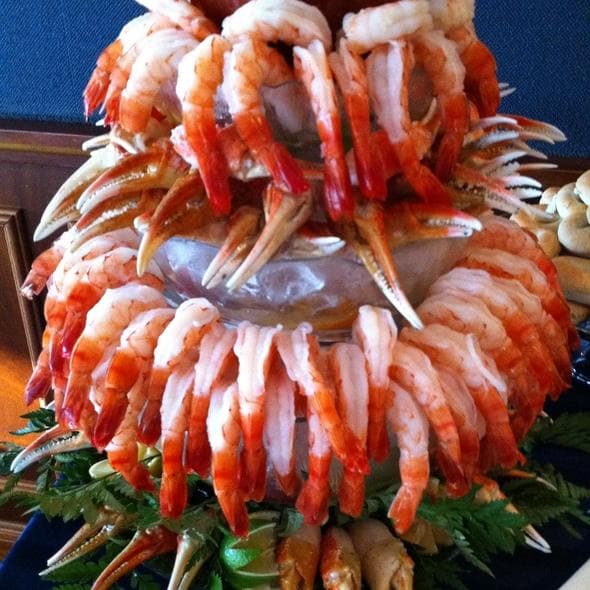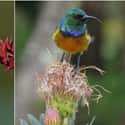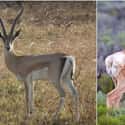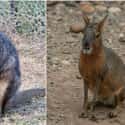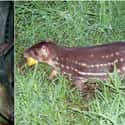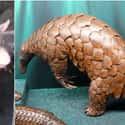-
(#1) Flying Squirrel And Sugar Glider
These two adorable little critters developed the whole "body-as-parachute" thing independently, believe it or not. On the left is the flying squirrel, commonly found in North America or Northern Europe. The other dude is a sugar glider, commonly found in Australia, New Guinea, and adorable YouTube videos. Their similar "wings" and big eyes are independent adaptations that evolved because they have similar lifestyles: they both leap from the tops of trees and forage at night. There's one big difference between the two: the flying squirrel is a placental mammal (like humans) while the sugar glider is a marsupial mammal (like a kangaroo).
-
(#2) Toucan And Hornbill
These two are actually technically unrelated, despite their obvious similarities. The toucan on the left is found in the American tropics. Toucans get all the press and love, but hornbills aren't too shabby, either. They are native to tropical Africa and Asia and also evolved a large-yet-light bill "to reach fruits from leafy branches that will not support their weight." This is a classic case of convergent evolution: their environments exerted the same "pressure" on the evolution that eventually formed those big bills.
-
(#3) Hummingbird And Sunbird
The familiar hummingbird on the left is a New World (Americas) bird, while the similar sunbird is from the Old World (Africa, Europe, and Asia). They belong to different orders but have similar lifestyles. Encyclopedia Britannica notes that they both "dart among tropical flowers, feeding upon nectar" and have a similar appearance because of how their feeding habits evolved (check out those bills). Some sunbirds also hover like hummingbirds when they feed. Their metabolic behavior is similar in certain species, too: both sunbirds and hummingbirds living at high altitudes have been known to enter a state of torpor at night, just like stoners in Denver.
-
(#4) Antelope And Pronghorn
These guys look remarkably similar, eh? On the left is an antelope (gazelle to be exact) and on the right is a pronghorn. Pronghorns are native to North America, while antelopes call Africa and Asia home. You know that classic American song "Home on the Range"? The one that goes, "Oh, give me a home where the buffalo roam/Where the deer and the antelope play"? There are no antelope in America. You've been lied to! Despite appearances to the contrary, the pronghorn's closest "relative" is actually the giraffe. They are, however, found in the same biomes as antelope, which likely led to their similar behavioral traits.
-
(#5) Kangaroo And Cavy
Yes, the little fella on the left is a small species of kangaroo, which helps to better illustrate the point, but even big 'roos share similarities with cavies (also known as a dillaby or mara). The cavy is typically found in Argentina, while the kangaroo is, as everyone knows, synonymous with Australia. The Lincoln Park Zoo's page on cavies sums it up nicely. Like kangaroos, their "rear legs are long...They are brown with white undersides, with hindquarters marked with a white patch. A large snout and large eyes are prominent on the face." The kangaroo, however, is a marsupial, unlike the cavy.
-
(#6) Chevrotain And Paca
The chevrotain on the left is native to Africa and Asia, while the paca is from South America. Convergent evolution, scientists say, led to them both have similar markings on their torsos. Despite their remarkably similar appearance, the chevrotain is an ungulate (hoofed animal) while the paca is a rodent. Their "similar environmental demands" made them analogous creatures of a sort, despite being separated by the Atlantic Ocean, fulfilling the same "roles" in their respective ecosystems.
-
(#7) Pygmy Hippo And Capybara
On the left is an African pygmy hippopotamus. On the right is a South American capybara. Evolution did a number on these guys: the capybara is the world's largest rodent, while the pygmy hippo is, duh, a tiny hippo. They have "converged upon comparable sizes," to quote Encyclopedia Britannica, with their similar-but-independent evolution. They are also both "semiaquatic residents of swampy tropical forest habitats" and both have "small, round ears, a short neck, a squarish muzzle, and no appreciable tail."
-
(#8) Rhea And Ostrich
Evolving into a flightless bird seems like it would be a huge disadvantage, but that's not keeping these guys down (except for how it is literally keeping them down). Convergent evolution led to the flightless rhea of the Americas (on the left) and the flightless ostrich of Africa. A rhea is smaller than an ostrich and has different coloration, but both species fulfill a similar "role" in their respective ecosystems.
-
(#9) Kangaroo Rat And Hopping Mouse
These cuties have independently evolved cool ways of coping with the desert heat. The kangaroo rat's desert is in North America (despite the name), while the hopping mouse hops around the deserts of Australia. Besides keeping cool in similar ways, they also both have, as Wikipedia notes, "a small rounded body shape with very large hind legs and long thin tails, a characteristic bipedal hop, and nocturnal, burrowing and seed-eating behaviors." Like most animals on this list that have convergently evolved, they also "fill similar niches in their respective ecosystems."
-
(#10) Mole And Marsupial Mole
These two are similar to the flying squirrel and sugar glider: remarkably similar in many ways, but different in one huge way. The Australian marsupial mole, as the name indicates, is indeed a marsupial while the standard North American mole is placental (like humans). But both species, as PBS notes, "burrow through soft soil to find and eat insects" and have a "streamlined body shape" with "modified forelimbs for digging." Australia's status as an island for the last 100 million years or so has led to fascinating cases of convergent evolution like this.
-
(#11) Groundhog And Wombat
Another case of convergent evolution, Australia-style. The wombat of Australia (right), much like the North American groundhog, "uses rodent-like teeth to eat roots and other plants" and "both animals excavate burrows." In fact, they both have the same "structure and type of teeth" due to the "same selective pressures" of evolution. And since this is Australia we're talking about, the wombat is marsupial, while the groundhog is placental.
-
(#12) Rabbit And Bilby
Besides being objectively cuter than the Australian marsupial bilby, European rabbits share quite a bit with them. They both have "well-developed hindlimbs, which reflect their hopping form of locomotion, and their long ears emphasize the important role of hearing," according to PBS. Like many of the other Australian examples on this list, the isolated status of the Land Down Under as an island for more than 100 million years led to cases of convergent evolution like this.
-
(#13) Wolf And Tasmanian Wolf
The badass Tasmanian wolf is, unfortunately, extinct, but only recently (1936). As the name implies, the Tasmanian wolf lived in Tasmania but also Australia, and was - like many Australian examples of convergent evolution - a marsupial. Being a marsupial and the tiger-like stripes on its back set it apart from wolves found in the rest of the world. It filled a similar "niche" as those wolves before it became extinct.
-
(#14) Giant Armadillo And Giant Pangolin
These tank-like bad boys are not related but evolved similar characteristics. The giant armadillo is a native of North America, while the giant pangolin is from Africa. Both are mammals, and both evolved hard exteriors due to similar environmental conditions and evolutionary "pressure." The armadillo evolved a shell made from "plates of dermal bone" while the pangolin got keratin scales (similar in nature to horns).
-
(#15) Giant Anteater And Spiny Anteater
These two anteaters don't look a whole lot alike, but they both behave in similar ways. They both have "a long, sticky tongue, few teeth, a rugged stomach, and large salivary glands" so they can live on a diet of ants. It's a very particular and kind of gross example of convergent evolution, but they did what they had to do, right? And they did it on entirely different continents: the giant anteater (on the left) is native to South America, while the spiny variety comes from Oceania.
New Random Displays Display All By Ranking
About This Tool
There are no genetically identical creatures, and even a random pair of identical twins will have subtle genetic differences. Due to individual differences, it is clear that the totally same species does not exist. But there are similar animal pairs with differences in the genetic structure, two different creatures that are geographically distant can converge and evolve to be very similar, such as the emerald tree boa and the Morelia Viridis.
There are more than 7 million species of animals living on the planet, sure that those species that look very similar are not surprised. The random tool lists 15 similar but unique animal pairs that are separated by a long distance.
Our data comes from Ranker, If you want to participate in the ranking of items displayed on this page, please click here.

